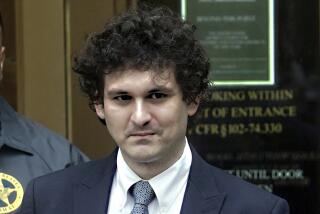Finding out what S&P; knew
- Share via
Reader Gary M. Barnbaum, an accountant and management consultant in Woodland Hills, took issue with The Times’ editorial Wednesday about the federal and state lawsuits against Standard & Poor’s. Although the editorial board welcomed the scrutiny of the credit rating agency’s bullish stance on mortgage-backed securities, it noted that “if the bubble hadn’t burst, S&P;’s ratings wouldn’t have proved so horribly wrong.” It’s one thing to deliberately mislead people, but “simply offering a bad opinion based on poorly drawn assumptions shouldn’t be grounds for liability.”
In a letter published Friday, Barnbaum wrote, “According to Michael Lewis’ book ‘The Big Short,’ everyone close to the situation knew that the mortgages that were bundled into those horrible securities were not just ‘flawed,’ they were garbage.... [F]reedom to express an opinion? Should PricewaterhouseCoopers not be held responsible for a bungled audit in which they render an unqualified opinion on the financial statements of a company? Yes, S&P; is responsible and should be liable.”
Editorial writer Jon Healey responds:
There’s a crucial difference between S&P; and PricewaterhouseCoopers. If the latter renders an expert opinion about a company’s books as part of a prospectus, it’s liable for any “material statement or omission” that harms investors. The ratings by agencies such as S&P; were exempted from liability until Congress passed the Dodd-Frank law in 2010, and the Securities and Exchange Commission has since extended the exemption indefinitely.
The U.S. Department of Justice and the state attorney general’s office raised a different issue: Did S&P; defraud investors by lying about how it formulated its ratings? In other words, the question isn’t just whether S&P; knew the housing bubble was going to burst; it’s whether S&P; was lying to investors about why they should trust its ratings.
The heart of S&P;’s defense is that its opinions about securities were just that — opinions — and no one had to believe them. The company maintains that its analysts had a constitutional right to express their views on how safe mortgage-backed bonds and collateralized debt obligations might be. The lawsuits don’t challenge that contention; instead, they assert that S&P; told the public its ratings were independent and objective when the process wasn’t.
The government’s evidence includes internal communications that purportedly reveal some S&P; employees’ concerns about ratings being skewed. Other internal documents purport to show that S&P; deliberately failed to update its risk evaluation, despite telling the public that it had done so, because the new data would have led to lower ratings and driven off customers.
The lawsuits are essentially an exploration of how S&P; came up with its ratings. The crucial questions there are whether that process was flawed in a way that belied the agency’s public assertions of independence and objectivity — an allegation S&P; vigorously denies — and whether those assertions persuaded investors to buy securities they otherwise would have avoided.
More to Read
A cure for the common opinion
Get thought-provoking perspectives with our weekly newsletter.
You may occasionally receive promotional content from the Los Angeles Times.






